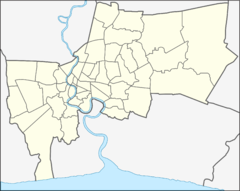This article relies largely or entirely on a single source. (January 2021) |
| Wat Suthat Thepwararam Ratchaworamahawihan | |
|---|---|
 | |
| Religion | |
| Affiliation | Buddhism |
| Location | |
| Location | 146 Bamrung Mueang Rd, Wat Ratchabophit, Phra Nakhon, Bangkok |
| Country | Thailand |
| Geographic coordinates | 13°45′04″N 100°30′04″E / 13.751028°N 100.501004°E |
| Architecture | |
| Founder | King Rama I |
| Completed | 1847/48 |
Wat Suthat Thepwararam (Thai: วัดสุทัศนเทพวราราม, Thai pronunciation: [wát su.tʰát tʰêːp.pʰá.wáʔ.raː.raːm]) is a Buddhist temple in Bangkok, Thailand. It is a royal temple of the first grade, one of ten such temples in Bangkok (23 in Thailand). Construction was begun by King Rama I in 1807. In the beginning, it was initially called "Wat Maha Sutthawat" (วัดมหาสุทธาวาส) and was located in a combretum grove. Further construction and decorations were carried out by King Rama II who helped carve the wooden doors, but the temple was not completed until the reign of King Rama III in 1847 or 1848. This temple contains the Buddha image Phra Sri Sakyamuni (Thai: พระศรีศากยมุนี; RTGS: Phra Si Sakkayamuni) which have been moved from Sukhothai Province. At the lower terrace of the base, there are 28 Chinese pagodas which symbolize the 28 Buddhas born on this earth. Wat Suthat also contains Phra Buddha Trilokachet (Thai: พระพุทธไตรโลกเชษฐ์; RTGS: Phra Phuttha Trai Lokkachet) in the ubosot (ordination hall) and Phra Buddha Setthamuni (Thai: พระพุทธเศรษฐมุนี; RTGS: Phra Phuttha Setthamuni) in the sala kan parian (meeting hall).
In 2005, the temple was submitted to UNESCO for consideration as a future World Heritage Site.
